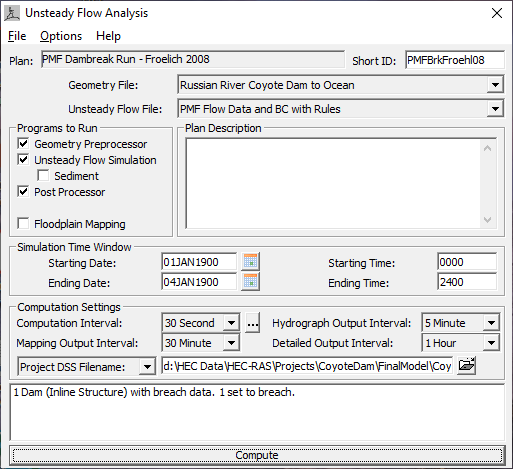This chapter shows how to calculate unsteady flow water surface profiles using the 1D Unsteady Flow solver in HEC-RAS. If the user is interested in 2D modeling, or combined 1D/2D, please review the 2D Modeling User's Manual. The chapter is divided into four parts. The first part explains how to enter unsteady flow data and boundary conditions. The second part describes how to develop a plan and perform the calculations. The third part focuses on calibrating an unsteady flow model, and the last part talks about model accuracy, stability, and sensitivity.
Once all of the geometric data are entered, the modeler can then enter any unsteady flow data that are required. To bring up the unsteady flow data editor, select Unsteady Flow Data from the Edit menu on the HEC-RAS main window.
Once all of the geometry and unsteady flow data have been entered, the user can begin performing the unsteady flow calculations. To run the simulation, go to the HEC-RAS main window and select Unsteady Flow Analysis from the Run menu. The Unsteady Flow Analysis window will appear as in Figure 7-14 (except yours may not have a Plan title and short ID).

Figure 7 14. Unsteady Flow Analysis Window
Calibration is the adjustment of a model's parameters, such as roughness and hydraulic structure coefficients, so that it reproduces observed data to an acceptable accuracy. The following is a list of common problems and factors to consider when calibrating an unsteady flow model.
This section of the manual discusses model accuracy, stability, and sensitivity. In order to develop a good unsteady flow model of a river system, the user must understand how and why the solution of the unsteady flow equations becomes unstable. This knowledge will help you figure out why your particular model may be having stability problems. Additionally, it is important to understand the trade-offs between numerical accuracy (accurately solving the equations) and model stability. Finally, model sensitivity will be discussed in order to give you an understanding of what parameters affect the model and in what ways.
Dam and levee breaching are a common application of the unsteady flow model in HEC-RAS because these processes are fundamentally unsteady. However, because of the rate of change and the uncertainties surrounding the parameters, these can be the most difficult unsteady flow modeling projects.
The HEC-RAS documentation has several sources of information on dam and levee breach modeling. This section includes an overview section and a section on each of the three major approaches to simulating the breach development:
There is also more information in the: